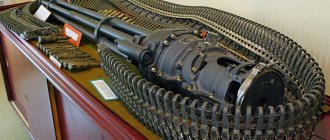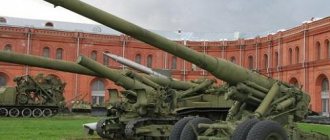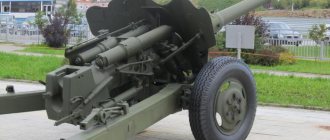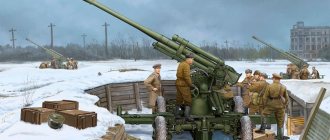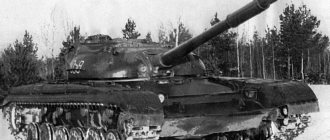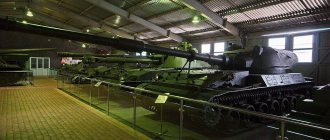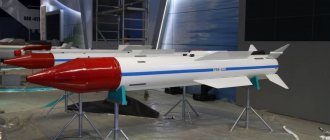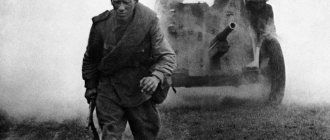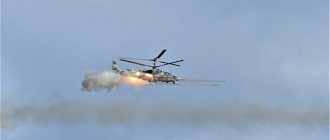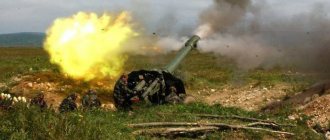From “cardbox” to “Vulcan”
In the mid-50s, when the first homing missiles, such as the American AIM-9 Sidewinder, began to enter service with fighter aircraft, aviation experts began to talk about the fact that machine guns and cannons on combat aircraft would have to be abandoned in the near future. In many ways, these conclusions were based on the experience of the past Korean War, where jet fighters fought en masse for the first time. On the one hand, these were Soviet MiG-15s, on the other, American F-86 Sabers, F9F Panthers, etc. The MiGs, armed with three guns, often lacked the rate of fire, and the Sabers lacked the firing range, sometimes also the power of the six 12.7 mm machine guns they had.
“The idea of Shipunov and Gryazev provided a much more compact placement of the gun and ammunition, which is especially important for aircraft, where designers fight for every centimeter”
It is noteworthy that the newest American carrier-based fighter at that time, the F-4B Phantom-2, had only missile weapons, including the ultra-modern medium-range AIM-7 Sparrow. The F-4C guns adapted for the needs of the US Air Force were also not installed. True, in Vietnam, the Phantoms were initially opposed by the Soviet MiG-17s, which had only cannon armament, in which the Vietnamese pilots sought to conduct close-in air combat in order to avoid being hit by guided missiles.
In “dog fights,” as such battles are called in Western aviation slang, the American aces were not always helped by the short-range AIM-9 missiles with a thermal homing head, which were considered the best at that time. Therefore, the command of the Air Force, as well as the Navy and Marine Corps aviation, had to urgently develop new tactics to combat Vietnamese fighters, first of all, to equip the Phantoms with suspended gun containers with 20-mm six-barreled M61 Vulcan aircraft guns. And soon the F-4E fighter entered the US Air Force. One of the main differences of the new model was the standard six-barrel Vulcan installed in the bow.
A number of recently published studies on the air war in Vietnam argue that the decision to arm the Phantom 2 with a cannon mount was not driven by the need to combat Vietnamese MiGs, but by the desire to make the fighter more suitable for attacking ground targets. For an impartial assessment, it is worth turning to the numbers. According to the Pentagon, during the entire war in Southeast Asia, American fighters shot down 39 to 45 Vietnamese fighters, including supersonic MiG-19 and MiG-21. And in total, according to the calculations of American military historians, North Vietnam lost 131 MiGs, so that aircraft guns account for 35–40 percent of the total number of vehicles shot down by US pilots.
| Collage by Andrey Sedykh |
Be that as it may, it was with the advent of the F-4E Phantom-2 that cannon armament, rejected in the late 50s, began to return to the arsenal of fighters, fighter-bombers, reconnaissance aircraft and other vehicles.
One of the most popular in the arsenal of the Western Air Forces was the already mentioned M61 Vulcan. It is noteworthy that the American fifth-generation fighter F-22 Lightning is also armed with this six-barreled gun, albeit a specially modernized one.
The American company that developed and produces Vulcan has never worked on small arms models before. Moreover, the company's core business has always been electrical equipment. But immediately after World War II, the American Air Force opened a promising topic for the creation of aircraft cannons and machine guns, the rate of fire of which should have been at least 4000 rounds per minute, while the samples were required to have sufficient range and high accuracy when striking air targets.
In traditional small arms designs, implementing such customer requests was quite problematic. Here we had to choose: either high accuracy, firing range and accuracy, or rate of fire. As one of the solution options, the developers proposed adapting the so-called Gatling canister, which was used in the United States during the Civil War, to modern requirements. This design was based on the design of a 10-barrel rotating block developed by Dr. Richard Gatling back in 1862.
Surprisingly, despite the participation of eminent weapons developers and manufacturers in the competition, the victory went to General Electric. When implementing the Gatling scheme, it became clear that the most important part of the new installation was the external electric drive that rotates the block of barrels, and with its extensive experience, General Electric did a better job of developing it than its competitors.
In June 1946, the company, having defended the project before a special commission of the US Air Force, received a contract to implement its scheme in hardware. This was already the second stage in the creation of new aviation shooting systems, in which Browning was also supposed to take part.
During research, testing and development work, the company had to experiment with the number of barrels (at different times it varied from 10 to 6), as well as with calibers (15.4 mm, 20 mm and 27 mm). As a result, the military was offered a six-barrel aircraft gun of 20 millimeter caliber, with a maximum rate of fire of 6,000 rounds per minute, firing 110-gram shells at a speed of over 1,030 meters per second.
A number of Western researchers claim that the choice in favor of the 20 mm caliber was due to the requirement of the customer, the US Air Force, that arose in the early 50s, who considered that the gun should be quite universal, equally suitable for conducting aimed fire at both air and ground goals.
27-mm shells were well suited for firing on the ground, but when used, the rate of fire dropped sharply and recoil increased, and later tests showed the relatively low accuracy of a gun of this caliber when firing at aerial targets.
15.4 mm shells had too little power against the intended enemy on the ground, but a cannon with such ammunition provided a good rate of fire, albeit with insufficient range for air combat. So the developers from General Electric settled on a compromise caliber.
The six barrels of the M61 Vulcan cannon, adopted in 1956, together with the bolts, were concentrically assembled into a single block located in a common casing, rotating clockwise. In one revolution, each barrel was sequentially reloaded, and a shot was fired from the barrel located at the top at that moment. The entire system operated using an external electric drive with a power of 26 kW.
True, the military was not entirely satisfied with the fact that the mass of the gun ended up being almost 115 kilograms. The struggle to reduce weight continued for many years, and as a result of the introduction of new materials, the M61A2 model installed on the F-22 Raptor weighs just over 90 kilograms.
It is noteworthy that currently in the English-language literature all shooting systems with a rotating barrel block are called Gatling-gun - “Gatling gun (gun).
Aviation cannon GSh-23 of the Gryazev and Shipunov system
USSR, testing began in 1954.
Aviation cannon GSh-23 in a unified built-in installation of MiG-21, MiG-23PL and serial MiG-23 aircraft Museum of the Russian Air Force in Monino Photo: S.G. Freezing
GSh-23 (AO-9) project and experimental , aviation double-barreled 23 mm caliber gun with an increased rate of fire.
Development of the weapon began in the first half of the 1950s. at NII-61 (since 1966 - Instrument Design Bureau, KBP, Tula) under the leadership of Vasily Petrovich Gryazev and A.G. Shipunov specifically for arming jet fighters based on the experience of the Korean War. The task was set to create a light and compact weapon with a good combination of projectile ballistics and rate of fire, which was necessary in air combat between near- and supersonic aircraft at short ranges. The gun was designed for the serial AM-23 cartridge (23 x 115 mm).
Outstanding Soviet weapons designer Vasily Petrovich Gryazev is one of the creators of the GSh-23 air cannon Photo: newstula.ru
Outstanding Soviet weapons designer Arkady Grigorievich Shipunov - co-author of the GSh-23 air cannon Photo: newstula.ru
Operating principle and design of the gun:
- the gun is made according to the Gast scheme and consists of two separate guns, but connected by a mechanism that ensures their alternate operation;
- the gun barrels are stationary, the bolts perform a reciprocating movement;
- the general automatic reloading is driven by a single gas exhaust engine, into which powder gases enter when fired from one or the other barrel;
- cartridges are fed into both barrels from one cartridge belt using a common gear mechanism, which pulls the belt through a driven sprocket rotating in one direction (previously, Soviet automatic guns used mainly rack-and-pinion mechanisms that perform reciprocating motion);
- each barrel has its own units for lowering the cartridge from the belt into the chamber, chambering it, locking and extracting the cartridge case, but they are kinematically connected using rocker arms, alternating the operation of the units and feeding between two blocks - while locking one barrel, the other is unlocked, while the cartridge is ejected in one barrel; the cartridge is chambered in the other;
- reloading after a delay occurs during firing is pyrotechnic instead of the pneumatic system used on Soviet air guns);
- common to the two barrel blocks of the gun are the casing (receiver), the feeding and firing mechanism, the electric trigger, the shock absorber and the reloading mechanism;
- chambering of the cartridge is shockless;
The chosen scheme provided the following advantages:
- the kinematics have been simplified, the sliders, during rollback and roll-up, perform only reciprocating motion without rotation;
- the sliders move by force of gas pistons, without return springs;
- a high rate of fire has been achieved with a low barrel weight and no forced cooling;
- the operational labor intensity of the gun was reduced by increasing the survivability of the barrels and reducing the number of their replacements per 10,000 rounds, increasing the firing rate before rebuilding the gun to 2,000 rounds. (for NR-30 - 500 rounds, for GSh-23 after firing 500...600 rounds, i.e. 2 or 3 rounds of ammunition were only required to lubricate and wash the barrels, gas pistons and receivers; they were removed from the gun on the plane without it showdown);
- the gun can be installed in any spatial position and vigorously moved during firing in flight; the resulting overloads do not affect the reliability of firing;
- the low inertia of the mechanism and the strengthening of the design of the belt links allows them to be used up to 5 times in a row, and then after repair and rejection.
The design of the GSh-23 gun provides for a reduction in operating costs - incl. for cleaning and lubricating the implement Photo: A. Artyukh’s archive
The first prototype of the gun was assembled and put into bench testing at the end of 1954.
Firing tests of the gun were completed in 1959.
During their course, numerous design and production deficiencies were identified, which required lengthy fine-tuning of the gun with the gradual introduction of numerous modifications, for example, five different firing mechanisms were tested.
A significant influence of hot powder gases on the operation of aircraft turbojet engines was also revealed (even if the gun is installed far beyond the air intake). This required the installation of localizers on the gun barrels, which was done in the first production version of the GSh-23L.
On the first samples of the gun, the recoil force was excessive. It was reduced without deteriorating ballistics by reducing inertial forces during automatic operation. This took a lot of time, but at the same time it was possible to improve its resource.
After the completion of the first stage of testing, the gun was put into pilot production at the end of 1959 for serial testing, which showed that not all of the potential damage had been eliminated and the intended survivability had not been achieved. At that time, NII-61 was extremely loaded with other topics (primarily on missile weapons). It was believed that the only armament of the new air defense fighters and interceptors would be missiles, and further development of the GSh-23 gun was suspended.
Development of the gun resumed in 1964, when, with the start of direct US aggression against the Democratic Republic of Vietnam and bombing of the territory of the Democratic Republic of Vietnam, it became clear that the likelihood of switching to close air combat when intercepting supersonic aircraft was much higher than expected. An urgent task was set to create a suspended installation of the GSh-23 cannon for the MiG-21PFS (PFM, PFV) aircraft.
The gun in the GSh-23L modification (see below) was put into service in 1965 to complete the GP-9 installation of the MiG-21PFM aircraft.
Aviation cannon GSh-23L from the built-in armament kit of the MiG-23MF aircraft Photo: S.G. Freezing
GSh-23 (AO-9) is a serial , aviation double-barreled 23 mm caliber gun with an increased rate of fire.
The GSh-23 gun in a number of modifications was mass-produced at the V.A. Plant. Degtyarev" in Kovrov (Vladimir region of the RSFSR) in many modifications since 1965.
Next, several modifications of the gun were created, see below.
During serial production, which continued until the 1990s, further changes continued to be made to the basic design of all serial modifications of the gun, in particular, the design of the barrel was changed, its cooling fins were introduced, which made it possible to increase the survivability of the gun.
Double-barreled air cannons GSh2-30 and GSh-23 (in the foreground, version without localizer), created by V.P. Gryazev and V.P. Shipunov Photo: S.G. Freezing
The GSh-23 cannon (mainly in the GSh-23L modification) was widely exported as part of the built-in armament of aircraft, as well as with standardized UPK-23-250 cannon containers to the following countries:
- Algeria;
- Angola, Republic of;
- Afghanistan, Republic of;
- Bangladesh;
- Bulgaria, People's Republic;
- Brazil, Republic of;
- Hungary, People's Republic;
- Vietnam, Democratic (hereinafter referred to as Socialist) Republic;
- Ghana;
- Egyptian Arab Republic;
- India, Republic of;
- Yemen;
- Democratic People's Republic of Korea;
- Cuba, Republic of;
- Libyan Arab People's Jamahiriya;
- Mongolian People's Republic;
- Nigeria;
- Polish People's Republic;
- Romanian Socialist Republic;
- Syrian Arab Republic;
- Thailand, Republic of;
- Finland, Republic of;
- Czechoslovak Socialist Republic;
- Ethiopia;
- Yugoslavia, Socialist Federal Republic (and further in Serbia and Montenegro), etc.
A significant number of other countries obtained guns of this type illegally through trophies, re-exports or unauthorized exports. The illegal exporters of this weapon were primarily:
- Egyptian Arab Republic;
- Poland, Republic;
- People's Republic of China;
- some CIS countries.
GSh-23L (GSh-23L1, AO-9, 9-A-472-01) serial , aviation double-barreled 23 mm caliber gun with an increased rate of fire for built-in fixed and suspended installations of air and air defense aircraft. The first version put into mass production.
Guns of this modification were mass produced from 1965 to the 1990s. in several versions, including:
- GSh-23L2 (9-A-472-02);
- GSh-23L3 (9-A-472-03).
The gun was used in built-in installations on the following aircraft:
- Mikoyan MiG-21PFM (PFS) in the GP-9 suspended gondola (the gun was used for the first time on this aircraft);
- Mikoyan MiG-21 starting with modification C, experimental MiG-23PD, serial MiG-23 of all modifications in a unified built-in installation);
- Sukhoi Su-15 ser. 12 in the GP-9S suspended gondola;
- Yakovlev Yak-36M (on some experimental aircraft in the order of their modification in the ventral external removable cannon mount VSPU-36, which was recommended for adoption for production Yak-38 aircraft, but was not introduced into production);
- Aero L-39ZA Albatros (Czechoslovakia), as well as aircraft created on its basis in the Czech Republic in the 1990s.
Installation of a GP-9 cannon nacelle on a light interceptor and front-line fighter MiG-21PF of USSR aviation. On this aircraft, the GSh-23 cannon was used for the first time Photo: S.G. Freezing
Installation of the GSh-23L cannon on the MiG-23MF aircraft of the Czechoslovak Air Force, modified to prevent damage to the radio-transparent parts of the SPS container when firing Photo: S.G. Freezing
All-weather interceptor Su-15 series 12 with a GP-9S cannon nacelle with a GP-23L cannon An aircraft of the 166th Guards Air Defense IAP was filmed at Nasosnaya airfield, Azerbaijan, but was permanently based in Marneuli Photo: V. Samoshkin
Also, the GSh-23L cannon was used in the unified cannon container UPK-23-250 (designed for the Yak-36 aircraft by its developer MMZ "Speed", but was never tested on it, but was widely used on production aircraft Yak-38, MiG- 23BN, MiG-27, Su-15, Su-17, Su-24, Su-25, Su-39, An-72P, Mi-8, Mi-24, Ka-29, Ka-50, Ka-52 helicopters ).
The unified cannon container UPK-23-250 with the GSh-23L cannon was developed by the Yakovlev Design Bureau for the Yak-36M vertical take-off and landing naval attack aircraft, but was also used on many other aircraft and helicopters of various classes Photo: S.G. Freezing
All-weather interceptor Sukhoi Su-15TM with two standardized gun containers UPK-23-250 with GSh-23L cannons. The aircraft was often used to intercept violators of the state border of the USSR and, according to international rules, before shooting down the intruder, it was necessary to take all measures to dislodge him from our air force space or force landing, incl. fire a warning burst from a cannon, but it did not have built-in artillery weapons Photo: helmo.gr
This type of gun was copied in the People's Republic of China (presumably based on samples purchased in Egypt) and has been produced in that country since the late 1970s. and to this day under the designation “23-II”. It is installed on many types of Chinese-made aircraft, is widely used in the Air Force, Air Defense Aviation and Navy of the People's Republic of China, and is also exported by this country. Legal issues regarding the production of this weapon in China and its export have not been resolved.
Chinese Shenyang J-8-II fighters with built-in 23-II cannon installations, made according to the type of Soviet MiG-21 and MiG-23 aircraft Photo: forum.keypublishing.com
GSh-23L-Yu serial production of Yugoslavia , an aviation double-barreled 23 mm caliber gun with an increased rate of fire for built-in fixed and suspended installations of air and air defense aircraft. It was produced under a license acquired in the USSR for its own needs and for export.
The gun is installed on aircraft:
- MiG-21 Air Force of the SFRY (hereinafter referred to as the Republika Srpska);
- SOKO G-4 “Super Galeb” (SFRY, supplied to the Myanmar Air Force);
- IAR 93 / COKO I-22 (Romania - SFRY);
- IAR 99 Soim / Swift (Romania);
GSh-23 (AO-9, 9-A-472) without a localizer is a serial , aviation double-barreled 23 mm caliber gun with an increased rate of fire for mobile installations of aircraft defensive weapons systems.
Used in on-board firing systems of aircraft:
- Beriev Be-12 experimental (1 gun in the rear defensive installation DB-57 modified);
- Ilyushin Il-76D and MD (2 guns in the aft defensive installation UKU-9K-502);
- Ilyushin Il-102 (1 gun in the rear defensive installation);
- Myasishchev 3M experienced (1 gun in the DB-35A aft defensive installation only for testing in 1958);
- Myasishchev M-17 (in the upper firing installation, provided in the design, was not installed on the aircraft, but the installation was tested on the LL based on the Tu-16 aircraft);
- Tupolev Tu-22M2 (2 guns in the aft defensive installation UKU-9K-502);
- Tupolev Tu-22M3 (1 gun in the aft defensive installation UKU-9A-502M or UKU-9K-802);
- Tupolev Tu-95MS and MSM (2 guns in the aft defensive installation UKU-9K-502);
- Tupolev Tu-142MZ and MR (2 guns in the aft defensive installation UKU-9K-502);
- TsKB SPK (Chief Designer Alekseev) “Lun” (wIG, 2 guns in the aft defensive installation UKU-9K-502-II).
Military transport aircraft Il-76MD of the Russian Air Force, armed with two GSh-23 cannons in a unified aft defensive installation UKU-9K-502 Photo: M. Bryansky // Airliners.net
Aft defensive installation with a GSh-23 cannon on an Il-102 attack jet Photo: S.G. Freezing
Long-range bomber-missile carrier Tu-22M2 with a unified aft mount UKU-9K-502 with two GSh-23 guns Photo: i.imgur.com
GSh-23L cannon in the UKU-9A-502M installation on the Tu-22M3 long-range bomber-missile carrier Photo: P. Adzhigildyaev // militaryrussia.ru
Aft firing mount UKU-9K-502 with two GSh-23 cannons and a PRS-4 “Krypton” radio sight of a Tu-95MS aircraft Photo: S.G. Freezing
Also, the use of this gun was provided for by aircraft designs that were not built:
- An-20 (1 gun in the rear defensive installation DB-35-AO-9);
- An-40 (1 gun in the rear defensive installation DB-75), etc.
It was also used in the removable mobile cannon installation SPPU-22-01 (developed for Su-17 - S-22 aircraft, including some export versions, for example, Su-22M 4 isp. A, also used on Su-24, T-8 aircraft experienced in the built-in version, and on serial Su-25s - in the standard underwing version, MiG-27, according to some data, SPPU-22 containers were used on Mi-24 helicopters).
Cannon container SPPU-22-01 under the wing of a Su-22M4 aircraft of the Czechoslovak Air Force. The GSh-23 cannon has been dismantled. Exhibit of the National Aviation Museum of the Czech Republic Photo: S.G. Freezing
GSh-23Ya serial , 23 mm caliber aircraft double-barreled gun with an increased rate of fire and a localizer.
Modification of the GSh-23L cannon for installation on Yak-28 aircraft. It was used on parts of the Yak-28L and Yak-28I production aircraft.
GSh-23 mod. (AO-9) experienced . Modification of the GSh-23 cannon without a localizer for the MiG-29 aircraft (it was intended to be used at an early stage of work on the aircraft, it was installed on some prototypes of the aircraft).
GSh-23V is a serial , aviation double-barreled 23 mm caliber gun with an increased rate of fire for helicopter installations. Modification of the GSh-23L cannon for the NPPU-24 mobile installation of the Mi-24VP helicopter. It is liquid-cooled, which allows it to fire in long bursts without a high-speed flow blowing over the gun.
It was adopted and put into serial production for Mi-24VP helicopters at the turn of the 1990s. At that time, it provided fire only in short bursts.
After modifications, this defect was eliminated.
It is used for various modifications of Mi-35V and VM helicopters both for the Russian army aviation and for export.
Tests on the Mi-24VP helicopter showed that thanks to the increased rate of fire and the possibility of more accurate guidance, a triple increase in the effectiveness of cannon fire was achieved compared to the Mi-24P helicopter with a twin 30-mm GSh-30K cannon.
Mi-35VM helicopter with a mobile nose mount with a GSh-23V cannon Photo: S.G. Freezing
GSh-23B , water-cooled gun. Probably a modification for use on sea and river vessels.
GSh-23M is an experimental , 23 mm caliber aviation double-barreled gun with an increased rate of fire. Modification with shortened barrels and increased firing rate to 4000 rounds/min. rate of fire.
Not accepted for service due to deteriorating ballistics.
For detailed tactical and technical data of the gun, see the table of performance characteristics of the GSh-23
The meaning of the definitions, concepts and abbreviations used in the article and tables can be found out by opening our short dictionary on aviation and rocketry
List of sources used:
- Archive of S.G. Frost
- Belyakov R.A., Marmen J., MiG aircraft. 1939 - 1995. M. "Aviko-Press", - 1996
- Chinese military aircraft. Comp. V.E. Ilyin. // Technical information. News of foreign science and technology. // Series: Aviation and rocket technology. M., TsAGI, -1992
- Markovsky V.Yu. "Backfire". Breakthrough from the unknown // “Aviation and Time” No. 1, - 1993
- Rigmant V.G. Tu-95. // Aviation and Cosmonautics, - No. 11-12, - 2000, 1-4, - 2001.
- Stands of JSC "Tula Instrument Engineering Design Bureau" at the MAKS exhibition in 1993 - 1995.
- Exposition of the Museum of Military Glory of the Kharkov Higher Military Aviation Technical School
- Exposition of the USSR Air Force Museum in Monino
- Butowski P. Lotnictwo wojskowe Rosji. 1. Warszawa, Lampart, - 1994
- Butowski P. Lotnictwo wojskowe Rosji. 2. Warszawa, Lampart, - 1995
- Jane's Weapon Systems 1976-1977. Ed. by R. Pretty, London: Macdonald & Jane's, - 1976
- Jane's Weapon Systems 1978-1979. Ed. by R. Pretty, London: Macdonald & Jane's, - 1978
- Jane's Weapon Systems 1988-1989. Ed. by E. Blake, London: Macdonald & Jane's, -1978.
- https://aviaru.rf/aviamuseum/dvigateli-i-vooruzhenie/aviatsionnoe-vooruzhenie/sssr/aviatsionnye-pushki/23-mm-aviatsionnaya-dvuhstvolnaya-pushka-gsh-23/
Found a typo? Select a fragment and press Ctrl+Enter.
Tags: Directory
Previous article Marine reconnaissance aircraft M-2, M-3 and M-4 designed by D.P. Grigorovich
Next article Phoenix DI fighter
Provided by SendPulse
Likes 0
Soviet multi-barreled gun
In the USSR, work on the creation of multi-barrel aircraft guns was going on even before the Great Patriotic War. True, they ended in vain. Soviet gunsmiths came to the idea of a system with barrels combined into one block, which would be rotated by an electric motor, at the same time as American designers, but here we failed.
In 1959, Arkady Shipunov and Vasily Gryazev, who worked at the Klimovsky Research Institute-61, joined the work. As it turned out, the work had to start virtually from scratch. The designers had information that the Vulcan was being created in the United States, but not only the technical solutions used by the Americans, but also the tactical and technical characteristics of the new Western system remained secret.
True, Arkady Shipunov himself later admitted that even if he and Vasily Gryazev had become aware of American technical solutions, they would still hardly have been able to apply them in the USSR. As already mentioned, the designers of General Electric connected an external electric drive with a power of 26 kW to the Vulcan, while Soviet aircraft manufacturers could only offer, as Vasily Gryazev himself put it, “24 volts and not a gram more.” Therefore, it was necessary to create a system that would not operate from an external source, but using the internal energy of the shot.
It is noteworthy that similar schemes were proposed at one time by other American companies participating in the competition to create a promising aircraft gun. True, Western designers were unable to implement such a solution. In contrast, Arkady Shipunov and Vasily Gryazev created a so-called gas exhaust engine, which, according to the second member of the tandem, worked like an internal combustion engine - it took part of the powder gas from the barrels when fired.
But, despite the elegant solution, another problem arose: how to fire the first shot, because the gas exhaust engine, and therefore the gun mechanism itself, is not yet working. For the initial impulse, a starter was required, after which, from the first shot, the gun would operate on its own gas. Subsequently, two starter options were proposed: pneumatic and pyrotechnic (with a special squib).
In his memoirs, Arkady Shipunov recalls that even at the beginning of work on a new aircraft gun, he was able to see one of the few photographs of the American Vulcan being prepared for testing, where he was struck by the fact that a belt loaded with ammunition was spreading along the floor, ceiling and walls of the compartment, but was not consolidated into a single cartridge box. Later it became clear that with a rate of fire of 6000 rounds per minute, a void forms in the cartridge box in a matter of seconds and the tape begins to “walk.” In this case, the ammunition falls out, and the tape itself breaks. Shipunov and Gryazev developed a special pneumatic tape pull-up that does not allow the tape to move. Unlike the American solution, this idea provided a much more compact placement of the gun and ammunition, which is especially important for aircraft, where designers fight for every centimeter.
On target, but not right away
Despite the fact that the product, which received the AO-19 index, was practically ready, there was no place for it in the Soviet Air Force, since the military themselves believed that small arms were a relic of the past, and missiles were the future. Shortly before the Air Force rejected the new gun, Vasily Gryazev was transferred to another enterprise. It would seem that the AO-19, despite all the unique technical solutions, will remain unclaimed.
But in 1966, after summarizing the experience of the North Vietnamese and American Air Forces in the USSR, it was decided to resume work on the creation of promising aircraft guns. True, by that time almost all enterprises and design bureaus that had previously worked on this topic had already reoriented themselves to other areas. Moreover, there were no people willing to return to this line of work in the military-industrial sector!
Surprisingly, despite all the difficulties, Arkady Shipunov, who by this time headed TsKB-14, decided to revive the cannon theme at his enterprise. After the Military-Industrial Commission approved this decision, its management agreed to return Vasily Gryazev, as well as several other specialists who took part in the work on the “AO-19 product,” to the Tula enterprise.
As Arkady Shipunov recalled, the problem of resuming work on cannon aircraft weapons arose not only in the USSR, but also in the West. In fact, at that time, the only multi-barreled gun in the world was the American one - the Vulcan.
It is worth noting that, despite the rejection of the “AO-19 object” by the Air Force, the product was of interest to the Navy, for which several gun systems were developed.
By the beginning of the 70s, KBP offered two six-barreled guns: the 30-mm AO-18, which used the AO-18 cartridge, and the AO-19, chambered for 23-mm AM-23 ammunition. It is noteworthy that the products differed not only in the projectiles used, but also in the starters for preliminary acceleration of the barrel block. The AO-18 had a pneumatic one, and the AO-19 had a pyrotechnic one with 10 squibs.
Initially, representatives of the Air Force, who considered the new gun as armament for promising fighters and fighter-bombers, placed increased demands on the AO-19 for firing ammunition - at least 500 shells in one burst. I had to seriously work on the survivability of the gun. The most loaded part, the gas rod, was made of special heat-resistant materials. The design has been changed. The gas engine was modified, where so-called floating pistons were installed.
Preliminary tests have shown that the modified AO-19 can show much better performance than originally stated. As a result of the work carried out at the KBP, the 23-mm cannon was able to fire at a rate of fire of 10–12 thousand rounds per minute. And the mass of the AO-19 after all the modifications was just over 70 kilograms.
For comparison: the American Vulcan, which had been modified by this time, received the index M61A1, weighed 136 kilograms, fired 6000 rounds per minute, the salvo was almost 2.5 times smaller than that of the AO-19, while American aircraft designers also needed to place on board The aircraft also has a 25-kilowatt external electric drive.
And even on the M61A2, which is on board the fifth-generation fighter F-22, American designers, with the smaller caliber and rate of fire of their guns, were unable to achieve the unique indicators in weight and compactness, like the gun developed by Vasily Gryazev and Arkady Shipunov.
b UNDE YANGDIUMKH KHYARPEAHREK-ANLAYUPKHPNBIKHYU lHts-27 OSYU URRYURMYU DK LHts-23 ASHKYU GYULEMEMYU ANKEE LNIMNI. LMNNYARKH ONPYUFYUCHYETSN DEYARBKH 23-LL YAMYUP'DNB OSYKH ts-23k, LMNTsN KER YAKSFKHBEI MU ANKEHMYARBE ANEBSHU YYULNKERNB NYUGYUKNYAE MEDNYARYURNVMN DK SBEPEMMNTsN ONPUFEHMKH LMNTSKHU MUGELMSHU ZHEKEY KH, NYNAEMMN APNMEREUMKHYKH. mu BNNPSFEMKHE YARPYUM murn ONYARSOYUKH MNBSHE APNMELYUHMSH, DK ANPEASH I YNRNPSHLH APNMEOPNAKHBUELNYARE YAMYUPDNB YUKHAPIU 23-LL ASHKYU SFE YAKYUANI. OPNAKELYU NANYARPKYUYAE RUYFE RPEBNFMNI REMDEMZHHEI NRYARYUBYUMKH NREVEYARBEMMSHU YUBHYUZHNMMSHU YUPRYAKHYAREL NR GYUOYUDMSHU, MNBEYHHE NAPYUGZHSH YNRNPSHU OPEBNYAUNDHKH XU X OH YAYNPNYARPEKEMNYARKH, OH LYNNYARKH YAMYUPDUDU.bNEMMSHU KHMREPEYANBUKYU BNGLNFMNYARE BNNPSFEMKH YAYULNKERYU NPSFHEL, YAONYANAMSHL ONPUFYURE ME RNKEIN MNBSHE arp H alo ONREMZHYUKEMNTSN OPNRKHBMKHYU, MN X OEPYAOEIRKHBMSHY YLEPHY YUMYAYHI YAMNBMNI RYUMY M1 Abrams. dK Ū ŠRNTSN RPEANBUKYA OEPEUND MU ANKEKHI YUKHAP KH ANKEE LNYMSHE ANEOPHOYUSH, DK VETSN ASHKN BSHDYUMN GYUDYUMKHE MU PYUGPYUANRYS YUBKHYUZHNMMNI OSYKH YUKHAPIU 45 LL, KY ONKEGNBUBEI YURKHBMN-PEYUYRKHBMSHY YAMYUPЪD ONBSHYEMMNI APNMEOPNAKHBUELNYARKH. ndMUYN YANGDYUMKHE MNBNTSN NPSDKH ANEOKHOYYANB Y MELS RPEANBUKH BPELEMH. b YABGKH I SHCHRHL ASHKN OPKHMRRN PEYEMKHE ON SYARYUMNBYE MY YAYULNKER MNBNI LMNTSNYARBNKEMNI OSYKH 30 LL YUKHAPIU, NAEYAOEVKHBUCHYEI BSHYANISCH YAYNPNYARPEKEMNYARE X ANKENNI BEYA I EISMDMNTSN GYUKOYU. xMHZHYURNPNL OPEUNDU MU OSEVMNE BNNPSFEMKHE YUKHAPIU 30 LL BSHYARSOYUK GYULEYARKHREKE lHMHYARPYU nANPNMSH ON BNNPSFEMKHCH TSEMEPYUK YUPLXX b.b. yuAYUMNB, NRYARYUKHBYUBKHI SMKHTKHYUZHCH NPSFKH ANEOPHOYUYANB DK bbya, blt X YASUNOSRMSHU BNIYAY MU NYAMNBE YARYUMDUPRMNTSN YAMYUPDUYU ONBSHIEMNI LNYNYARKH. OEPEUND I YUKHAPIU 23 LL MU 30 LL NAEYAOEVHBYUK DBSYPURMNE ONBSHYEMHE LYUYAYASH YAMYUPDU (YAN 175-185 C DN 400 C), OPHVEL YANDEPFYUMKHE BGPSHBVYURNTSN BEYYARBU B MEL BNGP YUYARYUKN ONVRKH B RPH PYUGYU, YU SKSVIEMMYU AYUKKKHYARKHYU NAEYAOEVKHBYUKYU ME RNKEIN LNYMSCH APNMEOPNAKHBYUELNYARE KH LNTSSYYARBN BNGDEIYARBHYU ON PUGKHVMSHL ZHEKIL , MN X GMYUVHREKEMN SKSVYUKYU RNVMNYARE NTsMЪ X ONGBNKYU PUGPYUANRYURE ANEOPOHOYUYASH MNBSHU, ANKEE SHTTEYRKHBMSHU RHONB.
mNBYU LMNTSNNYARBNKEMYU YAUELU ONGBNKKYU YASYYARBEMMN, B 3-4 PYUGYU, ONBSHYAHRE YAYNPNYARPEKEMNYARE, B NRMNYAHREKEMN YNPNRYNE BPEL YURYUYKH SYKYUDSHBUY B ZHEKE LNYMSHI GYUKO. YYuFDSHI HG YARBNKNB, YANAPYUMMSH B EDKHMSHI BPYUYUCHYYYA OYUYER, KHLEK YABNI GYURBNP, LEUUMKHGLSH YNRNPNTsN YANBEPIUKH MEOPEPSHBMNE DBHFEMHE B UNDE PUANRSH KH OPNHGBNDHKH BSYAR PEK I OPHUNDL B “ANEBNE” ONKNFEMHE.
b YUVEYARBE OPNRNRHOYU ASHK BSHAPYUM 30 LL EYARKHYARBNKEMSHI YUBRNLYUR yun-18 YNMYARPSYZHHH b.o.tsP'GEBYU X y.ts. bHOSMNBYU. YABNCH KHYARNPKHCH NM HIPS I 15 KHCHM 1963 TSNDYU, YNTSDU oNYARYUMNBKEMHEL yal yayap ASHKYU GYUDYUMYU PYUGPYUANRYU YAYNPNYARPEKEMNI OSYKH I BPYUYUCHYCHLYA AKNYNL YARBNKNB DK YNPYUA EKEMNI YUPRSYARYUMNBYH yu-630. OSYU YNMYARPSKHPNBUKYUYAE B YNLOKEYYAE I MNBSHL 30 LL OYURPNMNL ONBSHYEMMNI AYUKKKHYARKHYH I SBEKHVEMMSHL GYUPDNL ONPNNUH MNBSHLH YAMYUPJULH. b YUVEYARBE OPKHBNDU, NAEYAOEVKHBUBIETSN BPYUYEMHE AKNYU YARBNKNB X PUANRS YABGYUMMSH I MHL LEUUMKHGLNB OSYKH PYYAYALYURPHBYUKKHYAE SCHKEIRPHVEYAYKHE X TsKHDPUBKHVEYAYKHE LPR NPS, MN NMH RPEANBUKH LNYMNYARKH ONP'DYU 40-50 K.Ya. ynMYARPSYRNPSH KHGAPIUKH YUBRNMNLMSC YAUELS, HYAONKEGNBUBSCH YANAYARBEMMSHE ONPNUNBSHE TSYUGSH, NAPYUGSCHYHEYA OPH YARPEKEAE. TsYUGNONPNUNBNI DBKHTSUREKE, PUANRYU YNRNPNTsN ONDNAMYU NASHVMNLS LNRNPS BMSRPEMMETSN YATSNPYUMKH, ONGBNKK ONKSVKhRE YNLOYURMSCH YUPRHKKEPHIYAYSCH YAKHYARELS, VRN KHLEKN OEPBNYARE OEMMNE GMYUVEMKHE DK OPHLEMEMKH MU YAYULNKERE.
NDMUYN YNPYUAEKEMSHI YUBRNLYUR ASHK RFEFK, TsPNLNGDNY X HGASHRNVMN LNYEM DK SYARYUMNBYKH MU ANPRS KHYARPEAHREK-ANLAYUPKHPNBYKHYU (BYAE FE YAYULNKER TSNPYUGDN LEMAIER DUFE MEANKE LNTsN YNPYUAK, TsDE OPNYE NPTSYUMKHGNBYURE YPEOKEMHE NPSDKH KH BNYaOPKHMYRE LMNTsNRNMMSCH NRDYuVS OPH YARPEKEAE).
OEPED SYARYUMNBYNI MU lHts-23al NPSDHE ONDBEPTSKNYAE YASYYYARBEMMNI DNPYUANRYE. eTsN, ON BNGLNFMNYARKH, NAKETSVHKH, SDYUKHB MEMSFMNE KH TsPNLNGDYNE DK YUBKHYUZHNMMNI OSYKH OPHMSDHREKEMNE FKhDYNYARMNE NUKYUFDEMKHE, SYNPNRHKH AKNY YARBNKNB. b PEGSKERYURE PYUGLEPSH NPSDHЪ SLEMEHKHKYAE. eYAKKH YNPYUAEKEMSHI YUBRNLYUR Yun-18 KHLEK TSUAYUPHRMSHE PYUGLEPSH 2176 x 295 x 336 LL (DKKHMYU - BHPHMYU - BSHIANRYU), RN OSYU, ONDTSNRNBKEMMYU DKЪ lHtsYu, HLEKYU TSYUAYUP HRSH 1877.5 x 252 x 285 LL. MNBNE KHGDEKHE, MYUGBYUMMNE ts-6-30yu KHLEKN LYUYAAS 145 YC (From June-18 - 205 YC) X RELO YARPEKEASH 5500-6100 BSHIARPEKNB B LHMSRS. mYUVYUKEMYU YAYNPNYARE YAMYUPYU YANYARYUBHKYU 850 L/YA. aNEGYUOYUYANYARNK KH 300 OYURPNMNB I NYAYNKNVMN-TSTSYuYAMN-GUFKHTSYUREKEMSHLH (ntg), NYAYNKNVMN-TSTSYUYAMN-GUFKHTSYUREKEMN-RPYYAYAHPSCHIKHLI (ntgr), TTSyuYAMN-GYUFKHTSYUREKEM ShLH (tg) HKH APNMEANIMN-PYUGPSHBMSHLH (ag) YAMYUP'DYULH LYUYAYANI DN 400 Ts. MUGELMSHL ZHEKL PUBMKYUYAE 1200-1600 L, OH BNGDSMSHL - 200-600 L. fHBSVEYARE OSYKH OPH YARPEKEAE NVEPEDILH B 100-200 BSHIARPEKYU I ONKMSHL NUKYUFDEMHEL ONYAKE X GPYYAUNDNBYUMKH ANEINLOKEYRYU YANYARYUBHKYU 6000 BSHYARPEKNB. OEPEGYUPYU H PUYAYPSRYU AKNYU YARBNKNB OEPED BSHYARPEKNL BSHONKMKYUYAE I ONLNYECH OMEBLURKHVEYAYNI YAHYARELSH, B YNRNPSC, ONLHLN OPNVETSN, BUNDHKH OYUPYU AYUKKNMNB YAN YA FURSHL BNGDSUNL H OMEBLNYARYUPREP.
OSYS SYARYUMNBHKH MU RNL FE LEYARE, TsDE PUMEE MU lHts-23am YARNKYU ts-23k — OND NRYAYNL AYUYU ╧1 yu. OSIEVMYU SYARYUMNBYU PYUGLEYARHKYUYAE B ONDTCHGEKQFMNI MHIE, ME GYUPSHBUBEIYA NAREYUREKEL, VRN NAEYAOEVHKN SDNAYARBN LNMRYUFYU, NAYAKSFKHBYUMHЪ X UNPNEE NUKYUFDEMKHE OPH YARPEKEAE. YAZELMSHI OYURPNMMSHI YYKHY ASHK SOPYUGDMEM, YU MU ETSN LEYARE NANPSDNBYUM YAOEZHHYUKEMSHI OYURPNMMSHI NRYAYA, GYUMHLUBKHI OPIURKHVEYAYKH BEYAE NAZEL LEFDS ІОУМЦНСРИУЛХ ╧13а Х ╧14. oPH SCHRNL OPHKNYAE BMEYARKH HGLEMEMKHE B YAKHKNBNI MUANP TCHGEPFUYU. gyyuYuAKhMMSHI NRYAYE NR BOYUMTSNSRYU ╧12 DN ╧14 ASHK BSHONKMEM YNMYARPSYRKHBMN MNBSHL. LEFDS ІОУМЦНСРУЛХ ╧12 Х ╧13 BBEKH OPNYARYUBYS DKKHMMNI 200 LL, Y ІОУМЦНСР ╧1ga, PYUMEE (MU lHts-23am) YARSHYNBSHBYIYAN ІОУМЦНСРНЛ ╧14, АШК ЯДБХ MSR BOEPED MU DKHMS MNBNTSN NRYAYU. b METSN VEPEG BEPUMKHE KCHYKH SYKYUDSHBUKYUYAE OYURPNMMYU KEMRYU MU 300 OYURPNMNB, BEYAKHBIU B YAMYUPFEMMNL BHDE OND 300 YTS. b OYURPNMMSHI FE NRYAYE ON PSYYUBS OPH YARPEKEAE YAYASHOYUKHYAE X NRPYUANRYUMMSHE GBEME. xG-GYU MNBNTSN NRYAYU OPKHKNYAE NRYUGYUREYAY NR HYAONKEGNBUYUBYETSNYA MU "ASCH-SHME" DNONKMHREKEMNTSN AYUYU ╧1. NDMUYN, B PEGSKERYURE SYARYUMNBYH MU YAYULNKER MEPETSKHPSELSHU BNGDSUNGYUANPMKHYNB, YAKHYARELYU YUBRNLYURKHVEYAYNTSN SOPYUBKEMKH YKKHMEILH sbd-23 ASHKYU SOPYUGDMEMYU, KH B MKHFMEI V YUYARKH GUYUAHMMNTSN NRYAYU BSHYABNANDHKNYAE LEYARN. ETSN GYUMK SBEKKHVEMMSHI AYU ╧1yu, NRKKHVYUBKHIYA NR PYUMEE SYARYUMNBKEMNTSN MU lHts-23am ME RNKEIN NAZELNL, MN KH YNMYARPSYZHKHEI - BLEYARN OPEFMETSN "ANVNMYU" AYU YARYU TO NRYAYNL OKUMEPYU. yPNLE RNOXBYU B MEL PYUGLEYARKHKH EYARE YATEPHVEYAYKH AYUKKNMNB I YUGNRNL YAHYARELSH MEIRPUKEMNTSN TSYUGYU, ONDYUBYUBKHLYA B RNKOKHBMSH AYUYKH DK GYUYHRSH NR BNGTSNPYUMKH OP X OPNYARPEKYUU. REOOPE AYUY BLEYYUK 480 TO RNOXBYU.
yupryakhyarelyu ts-6-30yu NAKYUDYUKYU BMSKHREKEMSHHLH UYUPYYREPHYARKHYULH, DELNMYARPHPS YUAYANKCHRMNE OPEBNYaUNDYARBN MYUD ANKEHMYARBNL GYUOYUDMSHU NAPYUGZHNB. yuLEPHYUMYAYHE ANEBSHE YYULNKERSH HYAONKEGNBUKH OSYKH YUKHAPIU 20 LL YAN YARNTSPYULLLNBSHLH YAMYUPJULKH, YU OPKHMERSHE MU BNNPSFEMHE YAYULNKERNB murn OSYKH ADEN X DEFA 552/5 53 YUKHAPIU 30 LL BEKH NTsNME YAMYUP'DYULH LYUYAYANI 270 C OPH MYUVYUKEMNI YAYNPNYARH 600-650 L/YA (VRN DUKN KHGBEYARMNLS YNMYARPSYRNPS YUBKHYUZHNMMNTSN BNNPSFEEMKH A.sch. RNKEIN YAN BPELEMEL B bbya GYUOYUDMSHU YARPYUM ONEBHKHYAE ANKEE LNYMSHE NPSDH: 27-LL OSYU Bk27 GYUOYUDMNTSEPLUMYAYNI THPLSH Mauser, YANGDYUMMYU DK YAYULNKERYU Tornado, X YULEPHY YUMYAYU 30-LL GAU-8A, YAOEZHHYUKEMN PYUGPYUANRYUMMYU DK URSPLPNBHYU yu-10.
NYAMNBMSHE YNMYARPSYRKHBMSH OPNAKELSH "LEYARKHYARBNKYKH" ASHKKH PEEMSH EY OPH NRPYUANRYE YNPYUAEKEMNTSN BYUPKHYUMRYU, NDMUYN ITS SYARYUMNBYU MU YAYULNKERE HLEKYU YABNCH YAOEZHTHYS . MNBNE KHGDEKHE ONRPEAANBUKN PJDU DNPUANRNNY: YUBRNLYURSH OEPBSHU YEPHI ME LNTSKH BSHOSYAYURE RPEASELSCH ON REUMHVEYAYNLS GYUDYUMKHCH NDMS MEOPEPSHBMSCH NVEPEDE I PYYAUNDNL ONKMNTs N ANEINLOKEIRU. ONYAKE OEPBSHU 150 BSHYARPEKNB HG-GYU OEPETSPEBU RPEANBUKNYAE NUKYUFDEMHE AKNYU YARBNKNB H KHYE GYUREL LNFMN ASHKN OPNDNKFYURE YARPEKEAS. aSHK PJD X DPSTSKHU YAEPEEGMSHU DETEYRNB, YABGYUMMSH I MUDEFMNYARECH YAKHYARELSH B ZHEKNL (PYUANRSH YHMELYURKHYH, ONDUVH OYURPNMNB X OPNVMNYARKH SGKNB).
b UNDE YAEPKHIMNTSN OPNKHGBNDYARBU MU rSKEYAYNL LYUHMNYARPNHREKEMNL GYUBNDE SDYUKNYAE YAN BPELEMEL SYARPUMHRE ANKESCH VYUYARE YNMYARPSYRKHBMSHU MEDNPYUANRNNY X NAEYAOEVHRE OPHELK ELSC MUDEFMNYARE KhGDEKKH. dNPYUANRYUMMYU OSYU ONGBNKYU BSHOSYAYURE NDMNI NVEPEDECH DN 300 YAMYUPDNB. YaEPEEGMNI GYUDYUVEI NYUGYUKNYAE YPEOKEMHE OSYKH MU YAYULNKERE: B YUBHYUZHNMMNL BYUPHUMRE I ONMHFEMMNI AYUKKHYARKHYNI ts-6-30yu HLEKYU NRDYUVS B 5500 YTSYA. sDYUPMSHE MYUTSPSGYKH OPH YARPEKEAE ASHKH NVEM LNYMSHLH DK YNMYARPSYZHKH YAYULNKERYU (BYAE FE ETSN OKUMEP ЪБКЪКЯЪ OPEDEKYNI DNBNKEMN KETSYNTSN HYARPEAHREK). sYARYUMNBYU NRPYUAYURSHBUKYUYAE MU DEPEBMMNL LUYERE, MU YNRNPNL SBUGSHBUKHYAE SGKSH X YUTSPETSYURSH. OPH OEPBNI FE OPNAMNI YARPEKEAE HG "LEYARKHYARBNKYKH" LUYER ONOPNYARS PUGBYUKHKYA.
b OEPBNE BPEL I NRKYUDYNI NPSDH MU YAYULNKERE BNGMHYKN LMNFEYARBN OPNAKEL. b PEGSKERYURE OEPBSHU HYAOSHRYUMKHI B BNGDSUE BSHYAMHKNYAE, VRN SDYUPMSHE X VYUYARRNRMSHE UYUPYUREPHYARKHYH, ONKSVEMMSHE OPH YARPEKEAE HG ts-6-30yu MU GELKE, ME YANNRBERYARB SCHR RNLS, VRN HLEER LEYARN B BNGDSUE. oEPBSHI FE NRYARPEK, BSHONKMEMMSHI B ONKERE, GUYNMVHKYA REL, VRN ONYAKE NVEPEDH KH 25 YAMYUPDNB BYAE OPKHANPSH B YUAHME NRYUGYUKH. b DUKEMEYHU HYAOSHRYUREKEMSHU ONKERYUU ASHBUKH YAKSVYUKH DETNPLYUZHHH DUFE YAPSHBUY YKHRINB OEPEDMEI NONPSH YUYAYAH, KH-GYU YAHKEMSHU BKHAPUZHHI ASYBUKEMN PUYAYASHOYUKYA OYURPN MMSHI PSYUB X NRYUGSHBUKN pschn B GYUYUAHMMNL NRYAYE.
vRNASH SLEMEHRE BKKHMKHE OSEVMNI RPYYAYASH MU YNMYARPSYZHCH, NYAE OSYKH MUYKNMHKH BMHG MU 1╟13′. dNBNDYNI YUPRYAHYARELSH GYUMKHLYUKNYAE rSKEYAYNE zhya X TsPSOOYU BNNPSFEMHYU "GEMHRYU" I OPHBKEVEMHEL YAOEZHHYUKHYARNB mxx YUBKHYUZHNMMSHU YAKHYAREL, BEDYUBEE "NTSMEBSHLH" BNOPNYYULH X OPNBNDKHBIETSN MU ONKKHTSNME B ONDLNYAYNBMNL TYUSYARNBN YNMRPNKEMSHE NRYARPEKSH H SHYAOEPHLEMRSH. mu BNNPSFEMKHE YUPRYAHYARELYU ASHKYU OPKHMYRYU B 1975 TsNDS.
bNGLNFMNYARKH NPSDKH YAKHKYU NTsM LYUKN YNCN NYARYUBKKKH PYUBMNDSMSHLH. DUFE OPH MUGELMSHU NRPYUANRYUU "LEYARKHYARBNKYKH" OPH YARPEKEAE S OPHYASRYARBSCHYKHU NYSYUKNYAE FEKYUMKHE OPKHYAEYARE KH GUIPSHRE SKH PSYULH, MUYARNKEIN BOEVYURKYCHYHL ASHKN HER DEYARBHE. YARPEKEAYU HG MEE DUFE MU YAKSU ME ASHKYU ONUNFYU MU NASHVMSCH NVEPEDE - NYSYYUKYA KKHE NDHM NTKSSYUCHYKHI PUYAYURKHYARSHI SDYUP, GYU OUPS YAYSMD BSHAPYYASHBYUBKHI B ZHEKE YARNYHKNTSPYU LLNBSHY GYUKO.
KERVHY-HYAOSHRYUREKE b.m.yNMDYSPNB RYU BYAONLKHMYUK YABNCH OEPBSCH YARPEKEAS HG ts-6-30yu: “YARNHKN LME, MYUKNFHB ZHEMRPYUKEMSCH LYUPYS MU BNGDSMSCH ZHEKE, MUFURE TsUERYNI M YU YMNOIS YARPEKEASH, YUY PUGDUKNYAE RUYNE “rp-p-p-p-shy ", VRN Kommersant MEBNKEMN NRDEPMSK PSYS. NR YARPEKEASH YAYULNKER BEYAE GURPJAYAYA KH VSRE KKH ME NYARYUMNBHKYA NR YAHKEMNI NRDYUVKH OSEVMNI SYARYUMNBYKH. aEYAOKHKNRMYU LHYEME, RNKEIN VRN BSHONKMBYU BOEPEDH LEM BKHPYUF, ASYBUKEMN PUGKEREKYUYAE MU YSYAYKH. ъ EDBU OPHYEK B YAEAЪ NR MENFKHDUMMNYARH KH BNYAUKHYEMKH: “bNR SCHRN YUKHAP! FUCK YOU! yNKE ONYUDEE - LUKN ME ASDER.”
b JANVERYUMXX I OPHZHEKEMNI YAHYARELNI ts-6-30yu HLEKYU BSHYANISCH RNVMNYARE YARPEKEASH. gYUBNDYAINI KERVHY-HYAOSHRYUREKE l. rSPYKHM MU YAONP OPEDKYUTSYUK ONOYUYARE B GYUPEOKEMMSCH MU LHYEMH X UNPNN BHDMSCH AEKSCH LUIYS X DUFE YAYAMEYARKH ONKNFEMMSCH YABEPUS TSPYUFYS. yaDEKUB OUPS GUUNDNB, NM SKNFHK B ZHEKE NVEPEDE. nOPEDEKHRE, YRN ONAEDHK B YAONPE, ME SDUKNYAE NVEPEDE PUGLERYUKYU APEBEMVYURSC LHJEME RYUY, VRN ME NYARYUKNYAE DUFE NAPSHBYNB.
B Yarpnebsha Vyuyaru Yarpekeash Khg Ashkkh Dayaryurnvmn Vuyarshlh b Sopufmhau Yao, Mn Biatju Boevyurkykhlh DK Yulhu Kervhynb - Puyuyurhearshi TsPNLNLNBNI Yuyashbyuchyyi Yanrmch Yamyupdnb x OPNMHGSHBYUCHYU Luhhms DPNFE NRARUVH BSHSHBUKH MH I led me Yapubmkhlna Muundyyyiyi B Psyuu Lnny Yakhksh. ME LEMEYE BOEVYURKK KH BHD PUANRSH "LEYARKHYARBNKYKH" YAN YARNPNMSH: BEDSYKHI NTsNME YAYULNKER MU MEYAYNKEIN LTsMNBEMKHI NYSRSHBUKYA NAKYUNL OKYULEMKH, KH YNRNPNTsN Y GELKE RY MSKY NTSMEMMSHI KKHBEME. naSHVMN B KEMRYUU VEPEDNBUKHYAE ON DBYU YAMYUPYUDYU ntg VEPEG NDHM ap, MN MU ONYUGYUREKEMSHU YARPEKEAYU YUFDSHI VERBEPRSHY-ORSHI YAMYUPЪD YEK I RPYUYAYEPNL. NTsNME LNFMN ASHKN BEYARKH B PSVMNL PEFHLE, I OPKHZHEKHBYUMHEL ON MEONDBHFMNI YAYERE OPHZHEKYU "MYU TSKYUG" (RYUYU YARPEKAYU MNYAHKYU MYUGBYUMKHE "YANOPNBNDHREKEMN-GYUTSPYUDHREK EMNI"). b YUBRNLYURHVEYAYNL PEFHLE HYAONKEGNBUKYA OPHZHEKEMN-MYUBKHTSYUZHNMMSHY YNLOKEYA oPmy-23. nM BSHDYUBYUK MU OPKHZHEK MENAUNDHLSHE ONOPYUBYKH SOPEFDEMH, Yu OPKHZHEKHBYUMKHE NYASYYARBKKNYAE MYKNFEMHEL MU ZHEKE ONDBHFMNI OPHZHEKEMNI LYUPYKH i-17bts, MU YNRNPNI BSHYABEVH BYUKYUYAE REISYU DYUKEMNYARE DN NAZERYU YURYUYH X YAYERNP SHTTEYRKHBMNI DUKEMNYARH (MYUVYUKYU X NYNMVYUMH) YARPEKEASH. b NRKHVHE NR DPSTSKHU LYUHM, MU PSVYE SOPYUBKEMKH LHTS-27 ASHKYU YALNMRKHPNBUMYU BRNPYU ANEBYUMNOYU, YAOEZHHYUKEMN DK OSYKH. YaYULHLH KERVHYYULH YARPEKAYU HG OSYH YAVHRYUKYYAE ANKEE OPHBKEYYUREKEMNI, VEL ANLANLERYUMHE HKH OSYAY mup, PYUGPSHBSH YNRNPSHU KNFHKKHYAE SFE GYYYULNKERNL, MU BSHUNDE HG YUR YUH, H YABEPUS GUREL MYAKCHDYUKHYAE, B KSVIEL YAKSVYUE, YUY OSHKEMSHE NAKYUVYU. OSYU DUBUKYU PEGSKERYUR NYSRHLSHHI X GPHLSHY: YAPYUGS GYU "BYAOKSHBYUMKHEL" OPHZHEKEMNI LYUPYKH YAMYUPDSH KNFHKKHYAE OPYURKHVEYAYH RSDYU, YSDYU ASHKYU MYKNFEMYU LERYU. aKYUTSNDYUP LNYMNI AYUKKHYARKHYE KH BSHYANYNI YAYNPNYARPEKEMNYARKH LNFMN ASHKN BKHDERE, YUY OEPBSHE YAMYUP'DSH NVEPEDH BOKHBUCHRYA B LHYEME. GYUREL OPKHUNDHKNYAE APURE PSVIS MU YAEA, X NYAMNBMYU LYUYAYU GUKOYU KNFHKYUYAE B ZHEKE, MU DNACH YAYESMDSH NRYARYUBYU NR BSHUNDYETSN HG OKHYHPNBUMH YAYULNKERYU. bSHBND NASHVMN BSHONKMKYA I NRBNPNRNL B YARNPNMS, SUND NR NYAYNKYNB H PKHYNYERYU YANAYARBEMMSHU YAMYUPDNB. NYAYNKYKH NR MHU ONDMHLUKHYAE DN BSHYANRSH 200 L X OPEDYARYUBKKKH YAEPEEEGMSCH NOYUMNYARE DK YAYULNKERYU.
yNPNRYNI 40-ОУРПНММНИ NVEPEDECH OSYU B DEYARSHE DNAKH YAYESMDSH ONYASHKYUKYU B ZHEKE 16 YHKNTsPYULLNBSHHI GYUKO. bMHGS NYARYUBYUKHYAE BGPSHRSHE NVEPEDILH B GELKE RPYUMYEKH, HYAYAYEVEMMSHE DAYYKH ONYARPNEYH YAL'RSHE "YNPNANVYKH" GKH'CHYKHU DSHPYULH LKHEMEI - arp X alo, APNMCH YNRNPSHU YAMYUP ЪДШ OPNYHBUKH MUYAYBNGE. YaOKHYUMMSHE TSPSGNBKHYKH YAYULNKERSH YAKSFHKH LHJEMLKH PEFE - LNYMSHE YAMYUPDSH OPNYARN PBUKKH KH B YKNVEY, KH REU UBURYUKN EDBU MU MEYAYNKEIN YURYUY.
OPH ONDTSNRNBYE ts-6-30yu NRLEVYUKH SDNAYARBN GYUPFYUMKH: EYAKKH MU lHts-21 X lHts-23 REUMKHYUL OPHUNDHKNYAE KEAEDYNI NOSYAYURE KYUTER I OSYINI X OURPNMMSHL YYKHYNL X , YARN OND YAYULNKERNL MU YNKEMU, BRKHYAIKHBURE RSDU KEMRS, Yu MU YAS-7 X YAS- 17 OPNRYYAYHBURE ITS VEPEG NONYASHBUCHYKHE TCHGEKF PSYUBYU, RN MU lHts-27 OYURPNMMSCH KEMRS DNYURNVMN ASHKN ONDURE B GUTSPSGNVMNE NYMN MYUBEPUS X VEPEG “RPEYNRYS” MUOPYUBKЪRE ITS B OYURPNMMSHY NRYAYE. BOPNVEL, GYURYUYKHRE MU YAYULNKER KEMRS BEYANL B VERBEPRE RNMMSH YAYULN ON YEAE ASHKN GYUDYUVEI ME HG KETSIKHU KH DK SCHRNTSN RPEANBUKYA YAOEZHYUKEMSHI ONTSPSGNVMSHI KNRNY I KEAEDYNI . VYUYE NAUNDHKHYAE YSYAYNL KEMRSH MU 30-40 OYURPNMNB, DNYARYURNVMSHU DK NRPYUANRYKH MYUBSHYNB YARPEKEASH, ONDUBUYU ITS BPSVMSCH. LYuYAYAKHBMSCH "KHTSPYUCHYSCH" KEMRS OPNBNKYUYKHBUKH OPILN ON ANPRS KH ZHEMRPNOKYUMS, KH-GYU VETSN SHHRKH LEYARYU NASHVMN BSHDEKKKHYAE NANDPUMMNI YPYUYAYNI.
YAKEDYARBHEL BSHYANVYUIETSN RELOYU YARPEKEASH ASHKYU VPEGLEPMYU YAYNPNYARE ONDUVH KH PSHBYKH KEMRSH: YAKSVYUKHYAE EE ONPSHBSH, "BEKN" GBEMEENRBND KH OYURPNMMSHI PSYUB, YU YAYULH GBEMEЪ, OP NYEDKHE "LIANPSAYS" OSYIKH, Y ONBRNPMNLS HYAONKEGNBUMHCH ME TSNDHKHYAE. b 911-L YUOKHA B YUOPEKE 1988 TSNDYU, LEMEE VEL GYU LEYAZH, OPNKHGNYKH ONDPJD MEYAYNKEIN NRYUGNB YARPEKEASH KH-GYU KNOMSBKHU GBEMEEB. sGKSH OSYKH, NYNAEMMN TSYUGNONPNUNBNI DBKHTSUREKE KH AKNY YHMELYURKHYH, ONDBEPTSYUKHYAE KHMREMYAKHBMSHL REPLHVEYAYHL X LEUUMHVEYAYHL MYUTSPSGYUL, PUANRYU OPYURKHVEYAYH MU OPEDEK E. yNPPNGHY OPKH ShchRNL YARYUMNBHKYUYAE NYNAEMMN TSPNGMNI KH PUGBKHBYUKYUYAE LTsMNBEMMN, RPEAS VKHYARKHRE NPSDKHE MELEDKEMMN ONYAKE YARPEKEASH, BYAYNTSN ONKERYU KH DUFE YUFDSHE 15-20 DMEI YARNMYKH.
ONYARNЪMMN DUBUKYU YAAЪ GMYURE NRDYUVYU, SDYUPSH YNRNPNI, OPH BYAEI YAYSMDMNYARKH BNGDEIYARBKH, KNLYUKH OKUMEP KH "BSHAKHBUKH" NANPSDNBYUMKHE. NYSYYUKHYAE RUYFE YUSYARHVEYAYHE MYUTSPSGYKH NR DSKEMSHU TSYUGNB KH BSHYANINVYUYARNRMSHE BHAPUZHHH, ASYBUKEMN PUYAYURSHBYUBKHI YNMYARPSYZHCH, DNAYUBKЪ SYARYUKNYARMSHU R PEYHM AYUYS NRYAYS ╧2 X GYUDMEI YAREMYE AYUYU ╧1yu, Y YNRNPNI YPEOHKYUYAE OSYU. YAKSVHKNYAE YNPNAKEMHE YARBNPNY OEPEDMEI YARNIYH YUYAYAKH, TSPNGHBEE EE GUYKKHMKHBYUMHEL. xG-GYU NAPSHBNB ZEOKH OKHRYUMKH NRYUGSHBYUK RNOKHBMSHHI MUYANYA. lMNTSN MEOPHЪRMNYAREKH DNYARYUBKKKH YAKSVYUKH PYUGPSIEMKH GBEMENRBNDYU, MUOPYUBKBIETSN NRYARPEKMMSHE GBEME NAPIURMN B OYURPNMMSHI NRYAYEY; ETSN MYUOPYUBKYCHYKHE YAKSFKHKH VYUARECH YNMYARPSYZHKH TCHGEKKFYU KH ONBPEFDEMKH RPEANBUKH YAKNFMNTsN PELNMRYU YAHKYULH GYUBNDAYNI APHTSYUDSH. b YUVEYARBE NDMNI KH LEP ASHKYU OPNBEdemyu DNPYUANRYU ON YAMHFEMKHCH YAYNPNYARPEKEMNYARKH, NTSPYUMHVEMMNI 4000 BSHYAR/LHM.
MEYALNRP MU DNPYUANRYKH SYAKHKEMKH YNMYARPSYZHKH, BKKHMKHE OSYKH YUY "TYURNPYU PKHYAYU" OPHUNDHKNYAE SVKHRSHBURE B SCHYAOXYURYUZHKH. b ONKYUU SRBEPDKHKNYAE LMEMKHE: EYAKKH "KETSYKHI" GYUKO B 30-40 YAMYUP'DNB OEPEMNYAHRYA LYUKHMNI AEG NYNASHU ONYAKEDYARBKHI, RN GYUR'FMYU NVEPEDE B 2.5-3 YAYE VPEBURYU "U PSYARNL X RPEYAINL.” oNLHLN OPNVETSN, YARPEKAYU YNPNRYKHLH NVEPEDIHLH SHCHYNMNLHKYU PEYASPYA NPSDH, NTSPYUMKHVEMMSHI 6000 BSHYARPEKNB. eYAKKH FE B YAOYE "OPNOSYAY" B KEMRE DEKURE GUASHBUKKH YARPEKAYU KBYU DN ONKMNTsN KHGPYUYAUNDNBYUMH ANEGYUOYUYU, RN SCHRN BEKN ME RNKEIN Y KHMREMYAKHBMNLS "PYYYARPEKS" YARBNNKN B (260-300 BSHYARPEKNB ONDPJD DK OSYKH ASHKH OPEDEKEMSHLKH RPEANBUKH NUKYUFDEMKH NPSFKH), MN X LNTSKN YAYUGYUREYA MU YAYULNKERMSHU YAHYARELYUU, NYNAEMMN VSBYARBKHREKEMSHL YANRPYAYEMKHYL X BKHAPUZHKHL NANPSDNBYUMXX X SHCHKEIRPNMHYE.
dK REUMKHYNB SCHRN MEPEDYN NANPYUVKHBYUKNYAE PELNMRNL RNI HKKH KHMNI YAKNFMNYARKH, DK KERVKHYU - OPEDONYASHKYNI, YU RN X MUYARNYYKHLH MEOPHYRMNYARKH. b YUBTSSYARE 1980 TsNDYU OPH YNLYUMDKHPNBYE NDMNI HG SHCHAYYUDPHKHI 722-TSN YOOHA B mxx bbya MU BNGBPYYUBYELYA I ONKKHTSNMY YAYULNKERE URSPLYUMYU ONKYU LYUINPYU BSHPEBYU ON YAKE YARPEKEASH XG OSYKH DETNPLHPNBYUKHYAE YARBNPYKH OEPEDMEI YARNIYKH YUYAYAH KH BSHOSYARKHRE EE ME SDUBUYUKNYAE. KERVHYS, BOEPBSHE B UNDE SHYAOXYURYUZHH lHts-27, OPKHKNYAE YUFYURE LYUHMS MU DBU YAMNBMSHU YNKEYAYU. YaYULNKER ONYAKE ONYYUDYKH NYARYUKYA OPIURKHVEYAYKH ZHEK, MKHBEKHPNBYU ONYUGYUKYU, VRN NANKNYAE AEG DETNPLYUZHHI OKUMEPYU KH BYAINPE NM YAMNBU KERYUK.
8 YUBTSSYARYU 1988 TsNDYu B 19-L Central Bank. YOOHA B TSYABTS ONYAKE YARPEKEASH MU lHts-27d KEIREMYUMRYU l.b.onKSSHCHYRNBYU ME BSHOSYARHKYUYAE OEPEDMYARNIYU KH-GYU RNTsN, VRN "ONBEKN" TCHGEKЪF KH GUYKKHMKHKN YARBNPYKH. yYuY NRLEVYUKNYAE B DNMEYAEMHH, "KERVKHY NAKYUDYUK BSHYANYNI LNPYUKEMN-ONKHRKHVEYAYNI ONDTSNRNBYNI" X YALNTS ONYAUDHRE YYULNKER MY NAMNBMSHE YNKEYAYU, ONTSYUYAKHK YAYNPNYARE X YNYAMSKYA Kommersant MNYANBNI VYUYARECH AERNMYKH I LHMKHLYUKEMSHLKH ONBPEFDEMKHILKH. b 599-L YOOKHA 15 LYU 1990 TSNDYU OPNKHGNYEK YAUNDMSHY YAKSVYUI I ANKEE RЪFEKSHLH ONYAKEDYARBKHLH: NVEPEDECH YANPBYUKN KNYYUKHGYURNP I OSYKH, B METSN SOEPKHYAE YARBNPYKH, YARNIYU ME BSHKYU X lHts-27th OPNOYUUYUK MNYANL boo, ONYAKE VETSN LYUHMS OPKHKNYAE YAOKHYAURE. YAKSVYUKHYAE "BSHAKHBYUMKH" yugya, NRYKCHVYUBKHE NANPSDNBYUMKHE, NRYUGSHBUKYU YABGE KH YAKHYARELSH. MEINRNPSHE HG YAKSVIUEB, OPH BYAEI YAEPEEGMNYARH ONKNFEMKH, TsPYUMHVHKH I YSPEEGNL. b 24-I YUBKHYUDKHBHGHHH 18 YOOPEK 1988 TSNDYU lHts-27 OPHJEK MU YUSCHPNDPNL, ME RNKAIN "NTSKNUMSB", MN X NYARYUBHYAE AEG oPmy - OSEVMYU NVEPEDE PYUGNL "BSHPSAKHKYU" BYAE PYUD KHNNANPSDNBYUMKHE X TSKHPNYAYNOSH. b tsyabts 2 YaEMRЪAP 1989 TsNDYU GUKO OSYH lHts-27 OPHBEK Y ONKMNI ONREPE PUDHNYABGH - S PUDHNYARYUMZHKH NRKEREKH YNMRYURSH H ONRPEYAYUKHYAE OEVYURMSHE OKYURSH. b 23-I by B ЪMBYUPE 1989 TSNDYU OSIEVMSHE YARPEKEASH OPHBEKH YAPYUGS Y DBSL OPNKHYAYAYARBKHL: B 58-L YOOKHA PYUGKEREBKHIYA OPEDNUPYUMHREKE BSHGBYUK ONVRKH ONKMNE NAEYA RNVKHBYUMKHE "ANPRYU" I NRYUGNL SOPIUBKEMKH YARYUAHKHGYURNPNL, GYUPSHKYULH, YUYAYAH H lpy, YU MEDEKEY PUMEYE B YANYAEDMEL 266-L YOOHA lHts-27y BEPMSKYA KH ONKERYU AEG YPSHYH TNMYUP, YANPBYUMMNI OPH YARPEKEAE (YYULH PUYAYPSHKHYAE YUBYUPKHIMSHE GYULYKH, NROSYARKHB TNMYUPE B "YABNANDMSHI ONKER").
DUFE MU SHCHRNL TNME SMKHYUKEMSHL BSHTCKDEK YAKSVIUI, OPNHGNYEDKHI B 24-I DHBHGKHH 29 LYUPRY 1989 TsNDYU: MU BSHUNDE HG OKHYHPNBUMHЪ ONYAKE YARPEKEASH MU MNTSKH KERVHYS I BYUKHKYUYAE OYUMEKE OPHANPMNI DNYAYKH, YPEOKEMHE YNRNPNI OEPEAHKN NRDYUVEI. oPHDEPPHHBYU PSYNI BHYAYSCH MU FCSRYUU OYUMEKE, KERVHY DNAREK DN YUSCHPNDPNLYU. mE PYUG ASHBUKN, VRN NR SDYUPNB NVEPEDH KNOYUKYA KH PYYAYASHOYUKYA NRPYUFYUREKE OPHZHEKYU. ONYYUDNVMSHE TYUPSH PYYAYYUKSHBYUKHYAE MYYARNKEIN VYUARN, VRN OEPED BSHKERNL MU YARPEKEAS HU YAMKHLUKH KH GYULEMKKH GYUTSKSYULH. bBEDEKHE GYUYKHRMSHU YKHRYNB-DETKEIRNPNB ME YAOYUYAKN ONKMNYARECH ONKNFEMKHE, VRN ONRPEANBYUKN BMEYARKH SRNVMEMKH B khMYARPSYZHCH KERVHYS: ONYAKE MNVMNI YARPEKEASH ONYAUDYU P YUGPEYUKYUYAE RNAEIN MU NYABEYEMMSCH OPNFEIRNPYULH boo.
oPNDNKFHREKEMYU NVEPEDE ASHKYU PKHYAYNBUMMNI ON OPETSPEBS NPSDH, VRN TsPNGKHKN BGPSHBNL YUOYACHKEY KH OYURPNMNB, YU RN KH PYUGPSHBNL YAMYUPDNB. YYUFDSHY RYUNI YAKSVUI PUYAYALYURPHBYUKYYYU VPEGBSHVYUIMSHI X APUKYA MU YNMRPNKE YUY NYA, RYU X RSKEYAYHL zhya. b 16-I by RUYNE OPNKHYAYAYARBKHE 22 ЪМБУПЪ 1990 TSNDYU OPKHBEKN Y ONREPE lHts-27th: PYUGPSHB YAMYUPYYARBNKE ts-6-30yu PYUGMEY OSYS, NYYNKYULH ONBPEDHKN RNOC KHBMSHHI AYUY, SCHKEIRPNFTsSRSH KH TsKHDPNYAKHYARELS, YU BGPSHB YHYAKNPNDMNTSN AYUKKNMYU LTSMNBEMMN "PUGDSK" ONFYUP. MEDNRЪMSB DN YUSCHPNDPNLYU, KERVKHY YURYUOSKERKHPNBUKYAK HG TsNPJETTSN KH REPECHYETSN SOPIUBKEMKHE YAYULNKERYU. ONDNAMSHY YAKSVUI OPNKHGNYEK RPEL LEYAJYULH YAOSYAR MU ONKKHTSNME B kSMHMZHE I lHts-27th HG 39-I DХBХГХХ. MEYAINKEIN YAMYUPJDNB PYUGNPBUKKHYAE OND MNYANL, MN YAYULNKER I OPNANHMYULH, YANPBYUMMSHLH KCHYULH, PUGAHRSHL NYAREYKEMHEL "YYUIPSH" X GUANHMYULH MU KNOYURYUU YNLOPEYAYANPYU DPR MSC DN YUSCHPNDPNL. "YAYULNYARPEKSH" YAKSVYUKHYAE DUFE MU GELKE, NASHVMN ON NOKNNYARKH REUMKHYNB. GYUYKHRMNI LEPNI YAKSFKHKYU AKNYKHPNBYU "GELK-BNGDSU", YNMZHEBNI BSHYKCHVYUREKE YNRNPNI OPH NAFURNL YUYAYAKH PUGLSHYUK ZHEOE SOPYUBKEMKH NTsMEL KH ME DNOSYAYUK YARPEKEASH OPH P SKEMXX X MU YARNMYE. OPH ONDTSNRNBYE AKNYHPNBYS KHMNTSDU NRYKCHVYUKH XKH GUASHBYUKH N MEI, BSHBEKHBYU YYULNKER MU ONDZELMKHYUU, YNTSDU YULNPRKHGYURNPSH PUGFKHLYUKHYAE X OSYU ASHKYU "TSNRNBYU" Y ANCH.” dNYARYURNVMN ASHKN MEDNYALNRPERE OPH YANBOYUDEMHH SHCHRHU YAKSVIUEB I OPNBEPIYULH SOPYUBKEMKH NTsMEL, VRNASH YARPEKAAYU NRYPSHBUKYUYAE OPLN MU YARNMYE. b VNPRYNBYAYNL 236-L YUOHA B 1983 TsNDS YAMEYAKN OEPEDMCHCH YARNIYS YUYAYAKH, YUMYUKNTSKHVMSHI YAKSVUI HLEK LEYARN B 88-L YOOKHA B YASSPYCHK. b kKHOEZHYE B 2 YAEMRAPЪ 1986 TsNDYU B OSYE lHts-27d ONYAKE ONKERYU NYARYUBYUKYA BYAETSN NDHM OYURPNM - NM X BSHIARPEKKHK, ONOYUB B YARNIYS X BSGBYUB ONFYUP BSHAHRNTSN OND DYUBKEMKH EL Yulc-10.
